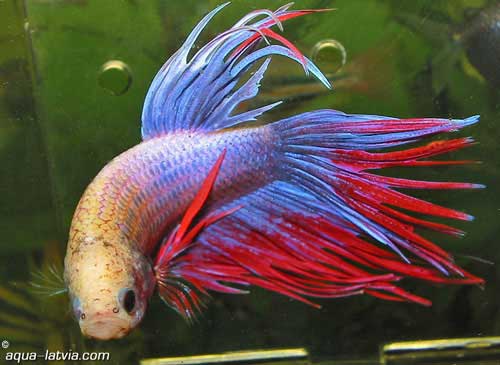
Bettas Can Breathe Air
Bettas or Siamese Fighting Fish are often sold in small bowls or cups, because bettas can breathe air directly. They don't need oxygen from the water like most other fish. Bettas will eat flake foods, but they will benefit from betta pellets. Although Bettas are often kept at room temperature in small bowls, they will do better in a heated aquarium. Frequent water changes are necessary if they are kept in a small container.
Betta Anatomy
The Betta originally came from mud puddles in southeast Asia. It is also known as the Siamese Fighting Fish, because males are totally intolerant of each other and will fight violently. Their distinctive feature is the long broad fins on the males. Females have very short fins. Bettas come in a variety colors and are very slow swimmers most of the time. They have a labyrinth which allows them to breathe air directly. You will find them continually at the surface of the water.
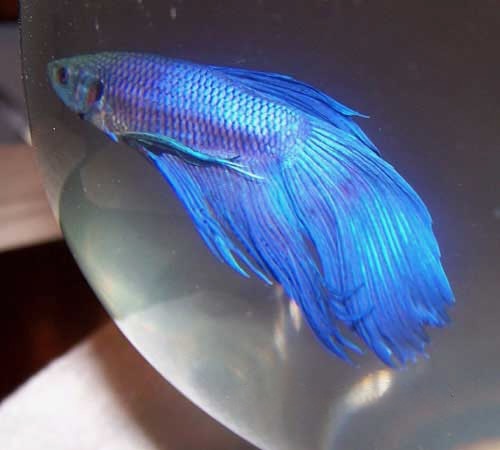
Breeding Bettas
Bettas are egg laying bubblenest breeders. The male blows bubbles which stick together and accumulate at the surface. A female can then be introduced. The male aggressively courts the female and spawns by wrapping and intertwining with her.
The female releases eggs which are fertilized by the male and float up into the bubblenest. The male cares for the eggs during the two days it takes them to hatch. He will take them into his mouth to clean them. After a couple of days the bubblenest dissolves as the fry emerge. Breeding Bettas is not difficult but ensuring the fry survive is more challenging.
Feeding Bettas
Comments on Feeding Bettas by LittleHippyGirl:
If you are worried about feeding a dry diet, you can try soaking and squeezing pellets so when you feed them, they have already expanded and there is no air left. They also sell a food called HBH supersoft pellets, but they are pretty big. I give break them into peices before feeding them to my bettas.
Freeze dried bloodworms will not sink no matter how long you soak them. They are good as an occasional treat, but don't feed too much or too often. Bettas LOVE mosquito larvae, so if you set up a bucket outside and moniter it, you can give them disease free live food without spending money.
Sterilized frozed food (except tubifex) is usually better on their stomachs, but if you aren't comfortable with it, feeding dry foods is fine. I've always fed them that and I've never had a problem as long as I don't feed too much. Betta's stomachs are about the size of their eye so they are easy to overfeed. Occasional fasting or supplementing their diet with boiled shelled peas helps keep their system clean.
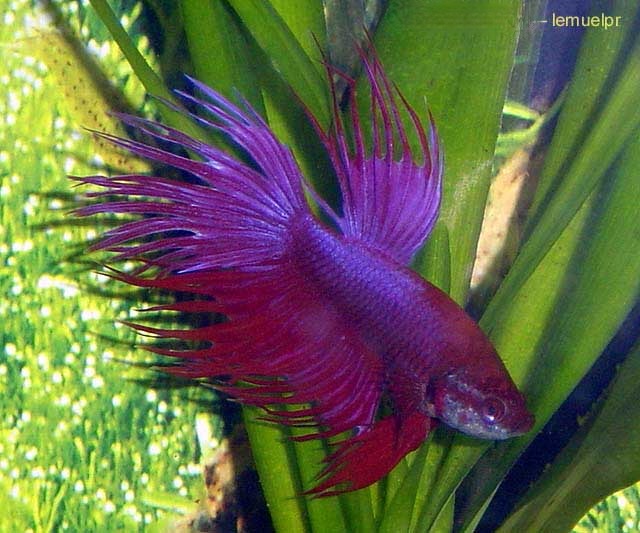
Comments on Feeding Bettas by kb46:
My bettas seem to live on air alone. I feed them once per day and rotate between flakes, tetramin, micro-pellets, hikari biogold pellets and frozen bloodworms. One eats flakes sometimes, the other eats micro-pellets sometimes. Most days I recover all of what I given them, except if it's bloodworms - both of them would gorge themselves if I let them.
Betta Sitting on the Bottom of the Tank?
Has your betta stopped swimming? It most likely has Swim Bladder Disease. Betta swim bladder disease causes your betta to have difficulty moving about. So, you may find your betta sitting on bottom of the tank almost motionless instead of swimming about. Causes of swim bladder disease:
- over feeding - It's the most common cause of swim bladder disease. Your betta can't process all the extra food to the point that it can't swim straight anymore. Stop feeding for a couple days to see if things improve.
temperature too cool - Bettas need a warm water temperature. Set the temperature to not less than 78 F. You might need a heater, especially in winter.
bacteria - Make sure your aquarium water is clean.
parasites - This is a less common problem, but if reduced feeding and warmer water don't help, then it's time to visit your pet store for advice.
Leaving Male Bettas with Fry
Comments on Leaving Male Bettas with Fry by Neoblaze550:
In order to make this spawn successful I suggest you have some experience in breeding bettas and taking care of betta fry ( this is not for beginners or people interested in having large spawns) first I introduced the male in his aquarium that is filled with alot of floating plants (water lettuce and water sprite) I also included a bundle of anacrus held down by a sinker and a small cave that the female betta and the fry can use when they are older. after the male was used to his surroundings I picked out one of my female bettas that looked extra plump and placed her inside a floating see through cup in the breeding tank. When the male saw the female he started to build a huge bubble nest under the floating water lettuce. I left the female in the cup for a couple of days until I noticed that she was ready to spawn, I waited about 4-5 hrs and the nest was already full or eggs (if you don't see eggs right away don't panic it can sometimes take 2 days) I took out the female and waited.
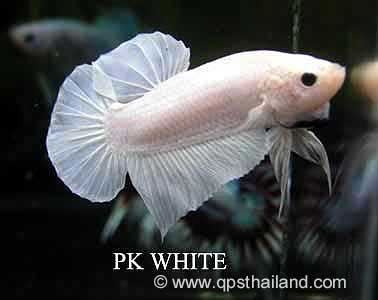
Surprisingly the eggs started hatching later that night and the dad was already showing good parental skills by not eating them and and he was retrieving the small fee falling fry and returning them to the nest ( If you notice him eating some don't worry he is just culling the weak ones). It's been about 5 weeks and the male has culled mast of his spawn but he has spared about 6 that are bigger than the fry that I breed the regular way. People say fry raised this way seem to be less aggressive, they grow faster, and they become better parents when they grow up.
So if you feel lucky I would definitely recommend this method.
Bettas - The Thai Way
The Thai Way (information submitted by a Thailand breeder)
In Thailand most breeders use some kind of plastic or pottery bowls. The small bowls or the tanks do not even have to be very clean. They use anything that they can fill water into. And the warm climate and all the live food like: mosquito larvae and insects makes it the ideal place to raise bettas (this goes for many other countries in the region).
When the Thai breeders breed bettas, they go for health and vitality. The first they look for is if any male has started to build a bubblenest in the jar. If there is a bubblenest, the breeder get a female that has bright colors. Then the pair is fed for 1-2 weeks with rich, high quality foods. So the pair are in their best health when the breeding starts. The male can be in the breeding tank up to 5-6 days without food.
The fry usually get egg yolk as their first food. Breeders feed the fry with egg yolk up to 7 days, twice a day. The fry grow very fast on the egg yolk, which is rich in protein. Even the smallest fry can get the yolk in their mouth. Breeders then feed the fry with baby brine shrimp and infusoria.
After 1 week, some breeders move the fry to outdoor ponds such as concrete tanks. Some breeders stop feeding the fry then and leave them to find their own food such us mosquito larvae. The weakest soon die.
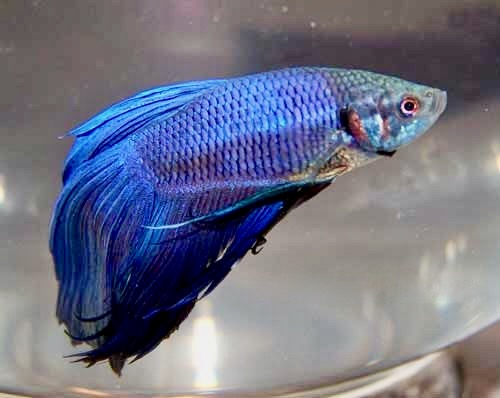
Keeping Female Bettas Together
Can you keep female bettas together? by LittleHippyGirl: To put it simply, yes. It is complicated though. Compatibility with bettas, both male and female, is a hard thing to describe because their personalities vary wildly. Sometimes a female is so aggressive that it can not be kept with anything else. That's not usually the case, but it happens more than some people think. If you want a group of girls to work out, there are a few things to consider.
Female bettas create a heiarchy. That means you need at least 4 or 5 females (preferably 5), because if the heiarchy is too small, bullying and aggression can become a major problem. Next is aquarium size....I'd say for a group of 4-5 female bettas, a 10 gallon aquarium would be a minimum. If you get a bigger aquarium, you can keep more girls easily. Territory is the last consideration. Buy all your girls at the same time, or at least put them in their tank at the same time. That way no one has a head start claim on territory and everything's fair. They will probably bicker and fight a lot the first 1-3 weeks because they are figuring out who's more dominant and who's more submissive. Keep lots of caves, coves and decorations as territory and hiding places.
Female bettas are great fish, and a tank full of them will be fun with their antics. You can also keep some sort of small peaceful fish without long fins in the tank if you like.
Betta Compatibility:
Male bettas are not compatible with other male bettas or female bettas. Female bettas are compatible. A lone male betta can be combined with Clown Loaches, Corydoras Catfish, larger Gouramis, Mollies, Platies, Red Tailed Sharks, Swordtails, Zebra Danios. Bettas are very territorial. Males will nip at fins and chase slow moving fish. Bettas will quickly injury male guppies.
***Comments***
Montezuma - You can put practically any fish in with your Siamese fighter. I have in my 60L tank a Siamese Fighter, Glass Catfish, Yucatan Sainfin Molly, 2x Guppy, Red Honey Gourami, Gold Gourami and two "Suckers". They all get along fine except for The guppies and Sailfin Molly. The only thing to keep away from the Siamese Figheter are fish with BIG/LONG tails. The Siamese will, with its history of fighting other males, try to attack these fish. Regards, hope this helps!
Alex - I have had a betta male with a bala shark, a red ruby shark, angels, corys, algae eaters ( yellow ones) rainbow, african butterfly, molies tetras and penguins. What is great is to have a few female bettas and an african butterly that is a very interesting fish. The bettas follow the butterfly, when I feed spiders or crickets and they nib the little pieces that fall out, when the african eats like 'Jaws" the cricket. It is like watching a big shark and the fish attached to it eat the sidedish from the meal.
Lemuelpr - Just wanted to tell you I added a CrownTail
Betta in my community tank!! Its being now more
than 2 weeks and no problemo. He's with 2 Discus,
an Angel, 4 Rainbows, a Killi, Emperor, Congo plus
some Tetras and everything good!!![]() The first days he was kind of scared and some
Rainbows tried to "taste" his tail and
the Betta kept his ground. No damage to anyone. He
now swims freely like nothing. He goes out and eat
with the big boys.
The first days he was kind of scared and some
Rainbows tried to "taste" his tail and
the Betta kept his ground. No damage to anyone. He
now swims freely like nothing. He goes out and eat
with the big boys.
Bored Betta Cures
Is your betta bored in its tank or bowl? Check out this great advice from RandomWiktor on Bored Betta Cures
Here's How I Breed my Bettas by Aquaman#1
Here is a good way to breed bettas. Start with a 2-10 gallon tank. Then get a Styrofoam cup. Cut in in 1/2 then get some rocks and hiding spaces for the females. Fill the tank 1/2 way. Add your male. Let the male stay in there for 1-2 days, so he will think it is his territory. Then 1-2 days latter add the female, but not where the male can reach her. Get a net breeder or breeding trap and put her in there. Just make sure you remove the V divider in the breeding trap. Now let your female stay in there for 1-3 days depending on how aggressive your male is. If your male is not really aggressive then add her in a day. If your male is aggressive then add her in two days. If he is extremely aggressive add her in three days. See the Idea is to get him used to her in his territory. Also the male Flares at her the same reason a Male peacock shows his feathers at the female. He wants to show her how big and pretty he is. He doesn't want to be mean.
How Do Bettas Mate?
After your 1-3 days add the femalie. Yes the male will maybe bite her and chase her. But don't feel sorry for her and take her out. Only take her out if she is like finless and about to die. Otherwise leave her in there. The male should have already started to built his bubble nest. After 1-4 days they will embrace each other. The female comes up to his nest and clamps her fins. And nudges him. Then he gets the idea ok I know what you want. They will embrace several times. The males picks up the eggs and puts then in the nest. The female stills lies motionless at the top for 30-60 seconds. Then she helps the male put the eggs in the nest. Once they are done the male now sees the female as a threat. He chases her off and tries to kill her. Put her in some treated water with bettamax. To help heal her fins. Her fins will grow back.
Male Betta Raising Fry
The males will tend to the eggs after this by cleaning them and yes eating some of the dead eggs. Sometimes the male is too young to know how to raise then the right way. After the fry become free swimming remove the male and feed the fry Infusoria and boiled egg yolk. Tiny bits now. Add two snails to help clean up the mess. Siphon out all messy food. And feed Brine Shrimp.
Betta Tropical Fish Profile
-
Scientific Name: Betta splendens
-
Family: Anabantid
-
Temperature: 24 - 28 C; 75 - 82 F
-
pH: 6.0 - 8.0
-
Size: 6 cm; 2.5 inches
-
Life Span: 2 years
-
Breeding: Difficult, Bubble Nest